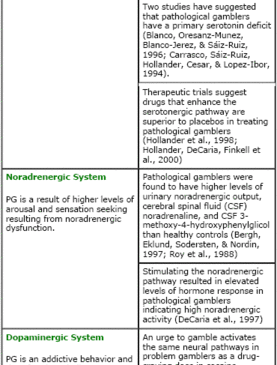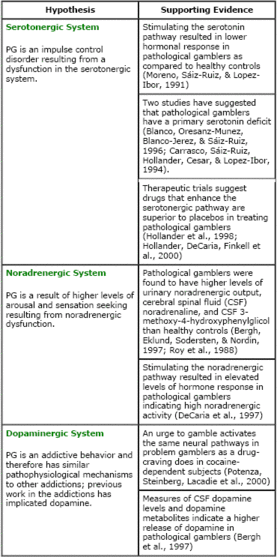Neurobiological research is expanding our understanding of the biological roots and influences associated with pathological gambling behavior. Several neurotransmitters have been implicated in the development of pathological gambling (PG). In a recent review of the literature, Ibáñez, Blanco and Sáiz-Ruiz (2002) examined the research supporting each of the more popular theories of pathological gambling. This WAGER presents a summary of their work in table 1 below.
Table 1. Neurobiological Hypotheses of Pathological Gambling with Supporting Empirical Evidence
Researchers have been investigating the role of genes in the development of PG generally and in the various pathways specifically. Studies of the first degree relatives and twins of pathological gamblers have found evidence of a genetic link (Eisen, Lin, Lyons et al., 1998; Ibáñez, 1997). Readers interested in more information about family studies should see WAGER 7(9). A next step in this program of neurogenetic research will be to isolate the genes that contribute to PG. Genetic research currently focuses on the serotonergic and dopaminergic genes because research indicates these influences are involved in PG. Preliminary genetic studies found that male pathological gamblers are more likely to carry a less functional allele variant for a serotonin transport gene (Comings, Rosenthal, Lesieur et al., 1996). This finding was not replicated in female pathological gamblers; however, women are more likely to carry a less functional allele variant for a receptor in the dopaminergic pathway (Perez de Castro et al., 1997). These findings suggest that genetic contributions might be gender-related.
With each scientific step forward, we gain a better understanding of pathological gambling and the etiological factors associated with its development. The body of research summarized above moves us closer to identifying the neurological pathways and associated genes that contribute to PG. Ultimately, these findings might enable an improved understanding of other behavioral disorders and lead to the development of more effective biological therapies for PG and other disorders.
Comments on this article can be addressed to Rachel Kidman.
References
Bergh, C., Eklund, T., Sodersten, P., & Nordin, C. (1997). Altered dopamine function in pathological gambling. Psychological Medicine, 27, 473-475.
Blanco, C., Oresanz-Munez, L., Blanco-Jerez, C., & Sáiz-Ruiz, J. (1996). Pathological gambling and platelet MAO activity: a psychobiological study. American Journal of Psychiatry, 153, 119
121.
Carrasco, J., Sáiz-Ruiz, J., Hollander, E., Cesar, J., & Lopez-Ibor, J. (1994). Low platelet monamine oxidase activity in pathological gambling. Acta Psychiatrica Scandinavica, 90, 427-431.
Comings, D. E., Rosenthal, R. J., Lesieur, H. R., et al. (1996). A study of the dopamine D2 receptor gene in pathological gambling. Pharmacogenetics(6), 223-234.
DeCaria, C., Hollander, E., Nora, R., Stein, D., Simeon, D., & Cohen, I. (1997). Gambling: biological/genetic treatment, government, and gambling concerns: neurobiology of pathological gambling. Paper presented at the Annual Meeting of the American Psychiatric Association, San Diego, CA.
Eisen, S., Lin, N., Lyons, M., et al. (1998). Familial influences on gambling behavior: an analysis of 3359 twin pairs. Addiction, 93, 1375-1384.
Hollander, E., DeCaria, C., Mari, E., Wong, C., Mosovich, S., Grossman, R., & Begaz, T. (1998). Short-term single-blind fluvoxamine treatment of pathological gambling. American Journal of Psychiatry, 155(1781-1783).
Hollander, E., DeCaria, C., Finkell, J.N., et al. (2000). A randomized double-blind fluvoxamine/placebo crossover trial in pathological gambling. Biological Psychiatry, 47, 813-817.
Ibáñez, A. (1997). Bases Genéticas de Ludopatía. Universidad de Alcala, Madrid, Spain.
Ibáñez, A., Blanco, C., & Sáiz-Ruiz, J. (2002). Neurobiology and genetics of pathological gambling. Psychiatric Annals, 32(3), 181-185.
Moreno, I., Sáiz-Ruiz, J., & López-Ibor, J. (1991). Serotonin and gambling dependence. Human Psychopharmacology, 6, S9-S12.
Perez de Castro, I., Ibáñez, A., Torres, P., Sáiz-Ruiz, J., & Fernandez-Piqueras, J. (1997). Genetic association study between pathological gambling and a functional DNA polymorphism at the D4 receptor. Pharmacogenetics, 7(345-348).
Potenza, M. N., Steinberg, M., Lacadie, C., et al. (2000). Neural activations associated with gambling urges in pathological gamblers. Paper presented at the American College of Neuropsychopharmacology Annual Conference, San Juan, Puerto Rico.
Roy, A., Adinoff, B., Roehrich, L., Lamparski, D., Custer, R., Lorenz, V., Barbaccia, M., Guidotti, A., Costa, E., & Linnoila, M. (1988). Pathological gambling. A psychobiological study. Archives of General Psychiatry, 45(4), 369-373.





